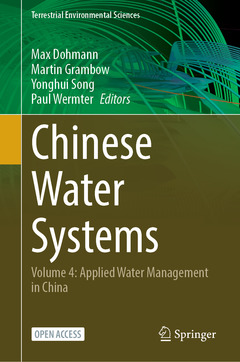1. Improving water management and the water management system in the Liao river basin and Lake Di
1.1 Structural Indicators
1.1.1 Development of innovative 3D Water Governance Models for Kunming City and Bavaria
1.1.1.1 Introduction
1.1.1.2 Materials and methods
1.1.1.3 Results
1.1.1.4 Discussion
1.1.2 Water Governance Structural Characteristics of Kunming City and Bavaria and Their Comparison
1.1.2.1 Introduction
1.1.2.2 Materials and methods
1.1.2.3 Results and discussion
1.1.2.4 Conclusion
1.1.2.5 References
2. Ecological indicators for surface water quality - methodological approaches to fish community assessments in China and Germany
2.1 Introduction
2.1.1 The need for ecosystem health assessment
2.1.2 Current situation in China and Germany
2.1.3 Ecological indicators of ecosystem integrity
2.1.4 Biological river assessment approaches applied in China and Germany
2.1.4.1 China
2.1.4.2 Germany
2.2 Methodological comparison of fish community assessment
2.2.1 Methodology
2.2.1.1 Choice of sampling methods
2.2.1.2 Area of experimental investigation
2.2.1.3 Description of sampling methods and design
2.2.1.4 Calculated metrics
2.2.2 Results
2.2.2.1 Fish Community
2.2.2.2 Method efficiency
2.3 Discussion
2.4 References
3. Dianchi Shallow Lake Management
3.1 Abstract
3.2 Introduction
3.2.1 Conceptual Thoughts connecting Water Management and Shallow Lake Management
3.2.2 Two studies for one goal
3.3 Study 1: Water and Sediment Monitoring Data Acquisition
3.3.1 Research Area
3.3.2 Materials and Methods
3.3.2.1 Sampling
3.3.2.2 Analytics
3.3.3 Results and Discussion
3.3.3.1 Analytics
3.4 Study 2: Shallow Lake Modelling of Lake Caohai
3.4.1 Theoretical Foundation and Adaptions
3.4.2 Data input and model parameterisation
3.4.3 Model simulation scenarios
3.4.4 Caohai Shallow Lake Model Results
3.5 Summary and Recommendations for the Dianchi Shallow Lake Management
3.5.1 Shallow lake management – a very special task
3.5.2 Necessity for highest Data Quality
3.5.3 Recommendations of most promising management scenario for the lake management
3.6 References
3.7 Annex
3.7.1 Annex 3-1 Full compares between aerobic and anoxic milie
3.7.2 Annex 3-2 Relevant parameters and variables of StoLaM used in the Lake Caohai simulation study
4. New technical approaches for the co-processing of pharmaceutical wastewater in municipal wastewater treatment plants in the Shenyang region
4.1 Introduction
4.2 New approaches for the co-treatment of municipal and industrial wastewater
4.2.1 State of wastewater treatment and upgrading plan in China and Shenyang
4.2.1.1 Administrative structure and legal basis for wastewater treatment and water protection
4.2.1.2 Institutions, procedures and challenges
4.2.1.3 Environmental problem and state of wastewater treatment in Shenyang
4.2.1.4 Status of pharmaceutical waste water treatment in China and the pharmaceutical company "Northeast Pharmaceutical Group Co, Ltd. in Shenyang
4.2.1.5 Parallel research activities
4.2.2 Innovative membrane technology in waste water treatment and the pilot MBR-treatment facility in Shenyang
4.2.2.1 Membrane filtration in wastewater treatment
4.2.2.2 Experimental installation: design, construction and operation
4.2.2.3 Project progress and operational phases
4.2.2.4 Sampling, measurement methods and parameter determination
4.2.3 Demonstration results and recommendations for upgrading actions in Shenyang
4.2.3.1 Presentation and comparison of results
4.2.3.2 Comparison of the treatment performance of the pilot plant with the reference treatment plant "GWSTP“.
4.2.3.3 Recommendations for upgrading the old municipal wastewater treatment plants in Shenyang
4.2.4 New approaches to the co-treatment of pharmaceutical wastewater in the municipal treatment plant
4.2.4.1 Description of the inlet situation of the test facility
4.2.4.2 Presentation of the results of important operating phase
4.2.4.3 Comparison and evaluation of results
4.2.4.4 Recommendation for action on pharmaceutical wastewater treatment in Shenyan
4.3 References
4.4 Annex
5. The planning, management and decision support systems of Kunming’s urban drainage system
5.1 Overview
5.1.1 Chinese Policy Background
5.1.2 Current Status and Problem Analysis
5.1.3 Methods
5.2 Managerial Decision Support System of Urban Drainage System
5.2.1 Data System
5.2.2 On-line monitoring system
5.2.3 Model Simulation System
5.2.4 Performance Evaluation System
5.3 Progress in practical application
5.3.1 Data construction and application
5.3.1.1 Data standard establishment
5.3.1.2 Data platform construction
5.3.1.3 Data feedback and application
5.3.2 Online monitoring application
5.3.2.1 Monitoring network construction
5.3.2.2 Water quantity analysis and decision in the Northern Catchment
5.3.2.3 Equilibrium Analysis of Water Volume for the Eastern and Southern Catchment Areas
5.3.3 Model Evaluation and Decision
5.3.3.1 Model Decision of the Storage Project in Western Catchment
5.3.3.2 Accurate pollution control decision in Panlongjiang Catchment
5.3.4 System joint operation
5.3.5 Summary of application benefits
5.4 Conclusion and prospects
5.5 References
6. Treatment of wastewater with high proportion of industrial wastewater with extreme requirements on the elimination of nutrients
6.1 Introduction
6.2 Industrial wastewater treatment in China
6.3 The study area and investigated wastewater treatment plant
6.4 Investigation approaches
6.5 Results of investigation
6.5.1 Indirect discharger monitoring
6.5.2 Optimisation of the existing sedimentation stage
6.5.3 Optimisation of nitrogen elimination
6.5.3.1 Optimizing the dosage of external carbon
6.5.3.2 Use of a downstream anoxic filter
6.5.3.3 Sludge water treatment
Operation of an SBR-MBBR experimental plant
Operation of a pilot plant for deammonification
6.6 Recommendations for future wastewater treatment in the investigated wastewater treatment plant
6.7 Summary
7. Adaption and introduction of German sewer inspection technology in China
7.1 Introduction
7.2 Stage of Urban Drainage Systems in China
7.2.1 Definition of Task
7.2.2 Conditions under which the Project was carried out
7.2.3 Present State of Science and Technology
7.2.3.1 Legal Situation
7.2.3.2 Recording of Sewer Condition – Hardware
7.2.3.3 Coding and Classification of Condition Recording
7.2.3.4 Conclusion
7.2.3.5 Management / Financing
7.3 Application of Advanced Sewer Inspection Technologies in Jiaxing
7.3.1 General Notes
7.3.2 First Demonstration of the Inspection Process
7.3.3 First Assessment of the Inspection Process
7.3.4 Second Demonstration of the Inspection Process
7.3.5 Second Assessment of the Inspection Process
7.4 Management Systems for Sewer Data Evaluation
7.4.1 Technology Development
7.4.2 First Demonstration of the Inspection Procedure
7.4.3 First Assessment of Process
7.4.4 Second Demonstration of the Inspection Procedure
7.4.5 Second Assessment of Procedure
7.6 References





